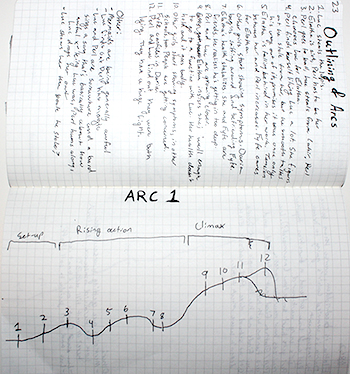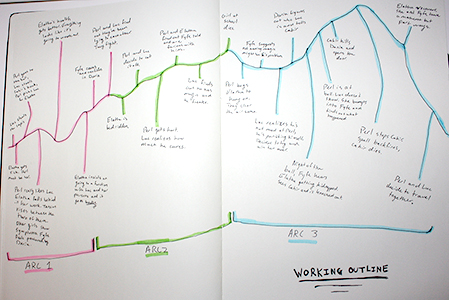Since my WIP, Illuminate, is also the thesis project for my graduate program, I don’t have as much time as I’m used to for fiddling around and rewriting stuff.
The logical response? Go absolutely crazy.
Step 1: Make Character Arcs for Everyone.
The Interwebs contain lots of great information about character arcs, so in brief: In the course of a story, characters will respond to conflict on an external and internal level, and by the conclusion characters will undergo some sort of change. This creates story arcs.
Every book has at least one major arc. I personally like Doug Tennapel’s advice to split stories into three acts, each with their own arc.
Here’s how I did it.
Write one sentence summaries for each character for each act.
I took my four major characters and wrote out a one line summary of what they would be learning/going through in each act. This helped me have a quick reference to the change they’d undergo in the course of the book.
Example:
Elizabeth Bennet
Act 1: She indulges in prejudice to come across as more witty.
Act 2: She learns that prejudice can cloud judgment, with bad consequences.
Act 3: She gives up her prejudices.
Write full character conflict sheets.
Disclaimer: My friend and classmate, Annie, passed this on to me. She got the idea from a blog entry but neither of us can find it. I’d be happy to edit this and give credit if anyone recognizes the material.
Next, I took six of the major/minor characters and filled out the following table with their information.
| Character Name: | |
| External Conflict | Internal Conflict |
| Inciting Incident | Inciting Motivation |
| Escalating Troubles | Pressure Mounts |
| Resting Point | Hope Restored |
| Major Crisis | Hope Destroyed |
| The Black Moment | All is Lost |
| Turnaround | Courage Emerges |
| Climax | Courage Displayed |
| Denouement | Courage Confirmed |
This helped me see which characters weren’t growing and where there were opportunities to up the stakes. One character’s arc was literally “she gets sick, then sicker, then even more sick.” I didn’t realize that horrible arc was happening till I had to write it down. Needless to say, that’s been revised, and the result is much stronger.
Turn your sheets into a timeline.
One thing about doing these sheets for multiple characters is that not all your characters’ arcs will start at the same part. My antagonist’s arc begins well before the beginning of the book, for instance.
By creating a timeline you can have an easy way to see what’s happening when to who. I choose to color code mine to help me easily see what was going on.
Sample:
Step 2: Write Out Arc Outlines.
I used sticky notes to mark the different acts on my timeline. Then, in my journal, I wrote out each step along the way in each act and graphed each act on the accompanying page. I added extra scenes to an “other” category under my lists.
Sample:
Step 3: Write Out a Complete Outline.
When I had all my individual arc outlines, I decide to take the plunge and make a big outline graph in my large journal. I copied down the most important information and used sloping lines to show how each step affected the tension of the story. (It’s debatable if my lines makes any sense.) Then I highlighted the different acts.
Sample:
And voila! I now am the proud owner of an insanely organized series of plots, outlines, and character arcs.
(You can take it a step further and mark out where chapter breaks will be. I’m considering it, but I think I might live on the wild side and actually decide on breaks as I go.)
Do you have your own crazy outlining methods? Share below!





















